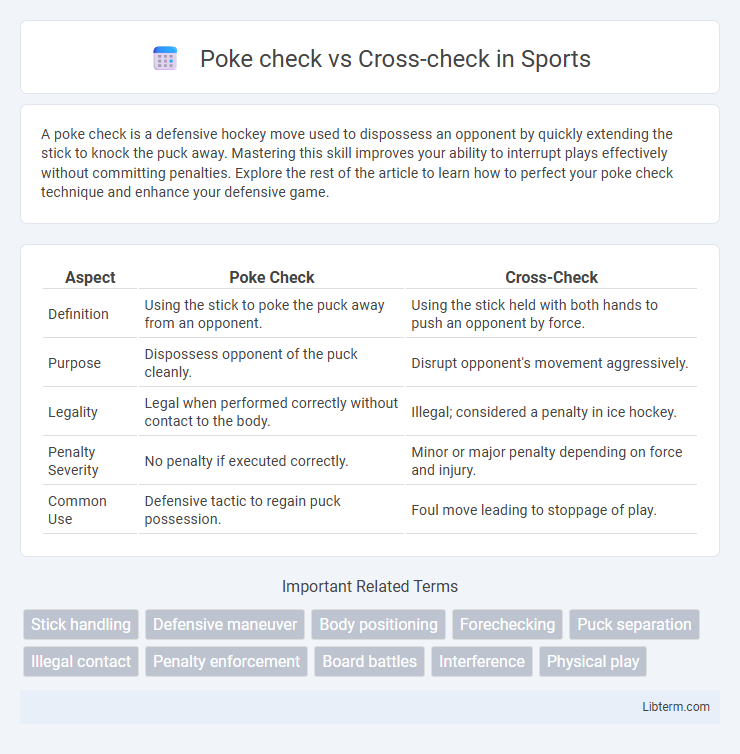A poke check is a defensive hockey move used to dispossess an opponent by quickly extending the stick to knock the puck away. Mastering this skill improves your ability to interrupt plays effectively without committing penalties. Explore the rest of the article to learn how to perfect your poke check technique and enhance your defensive game.
Table of Comparison
| Aspect | Poke Check | Cross-Check |
|---|---|---|
| Definition | Using the stick to poke the puck away from an opponent. | Using the stick held with both hands to push an opponent by force. |
| Purpose | Dispossess opponent of the puck cleanly. | Disrupt opponent's movement aggressively. |
| Legality | Legal when performed correctly without contact to the body. | Illegal; considered a penalty in ice hockey. |
| Penalty Severity | No penalty if executed correctly. | Minor or major penalty depending on force and injury. |
| Common Use | Defensive tactic to regain puck possession. | Foul move leading to stoppage of play. |
Understanding the Basics: Poke Check vs. Cross-Check
In ice hockey, a poke check is a defensive maneuver where a player uses their stick to swiftly knock the puck away from an opponent, emphasizing precision and timing. Cross-checking involves using the shaft of the stick with both hands to forcefully check an opponent, which is considered a penalty when done improperly. Understanding these fundamental differences is crucial for effective defensive play and maintaining game legality.
Definition and Technical Difference
A poke check in hockey is a defensive move where a player uses the stick to quickly jab or poke the puck away from an opponent, emphasizing precision and timing. A cross-check, however, involves using the shaft of the stick held with both hands to forcefully push or hit an opposing player, which is typically penalized as illegal body contact. The technical difference lies in the poke check targeting the puck with a quick stick motion, while the cross-check uses the stick as a physical weapon against an opponent's body.
Historical Evolution in Hockey
The historical evolution of poke check and cross-check in hockey reflects the sport's development in defensive tactics and rule enforcement. The poke check, originating in the early 20th century, became a fundamental skill for players to disrupt opponents' puck control using a swift stick thrust without body contact. Cross-checking, emerging as a more aggressive and illegal maneuver, led to stricter officiating and rule clarifications by the NHL to maintain fair play and player safety over decades.
Techniques: How to Execute a Poke Check
A poke check is executed by quickly extending the stick blade to jab the opponent's puck away, requiring precise timing and stick control to avoid penalties. Proper technique involves staying low with knees bent, eyes on the puck, and using a short, sharp poke motion while maintaining balance to recover quickly. Effective poke checks disrupt puck possession without making physical contact, differentiating them from cross-checks, which involve forceful stick contact and often result in penalties.
Techniques: How to Execute a Cross-Check
Executing a cross-check involves using the shaft of the hockey stick with both hands to deliver a forceful check to an opponent, usually targeting the upper body or back. Proper technique requires maintaining control and balance while swinging the stick in a controlled manner to avoid penalties. This differs from a poke check, which uses the stick blade to quickly knock the puck away without physical contact.
Strategic Uses in Game Situations
Poke check and cross-check serve distinct strategic roles in hockey defense, with poke checks enabling precise puck dispossession through quick stick maneuvers, ideal for intercepting passes or disrupting offensive plays without risking penalties. Cross-checks involve using the shaft of the stick to apply force on opponents, often to impede their progress or create physical presence, but carry a higher risk of penalties and are best utilized selectively in maintaining defensive pressure. Effective game strategy balances poke checking to maintain clean defense while reserving cross-checks for critical moments requiring assertive physical engagement.
Legalities and Rule Differences
A poke check involves using the stick to knock the puck away from an opponent without physical contact, making it a legal defensive move under hockey rules. Cross-checking occurs when a player uses both hands to forcefully push an opponent with the shaft of the stick, resulting in a penalty due to illegal physical contact. Rulebooks distinguish poke checks as skillful, clean plays, while cross-checks are penalized to maintain player safety and fair competition.
Common Mistakes and Penalties
Poke checks often lead to penalties when players make excessive contact or miss the puck, resulting in tripping or slashing calls. Common mistakes during cross-checks include improper use of the stick with two hands, causing illegal contact and immediate penalties. Understanding the distinction between legal stick positioning in poke checks and the forceful nature of cross-checks is crucial to avoid infractions and maintain fair play.
Impact on Player Safety
Poke checks and cross-checks differ significantly in their impact on player safety, with poke checks being a controlled defensive technique aimed at disrupting puck control without physical contact. Cross-checks involve using the shaft of the stick to forcefully strike an opponent, often resulting in penalties due to increased risk of injury. The NHL enforces stricter rules against cross-checking to minimize injuries, promoting safer gameplay and protecting players from potential harm.
Choosing the Right Defensive Move
A poke check involves using the stick to quickly lift or poke the puck away from an opponent, ideal for close, tight situations requiring precise timing and stick control. A cross-check, which is more forceful and involves using the shaft of the stick between both hands to push an opponent, is often penalized and should be avoided except in rare physical battles where legality is assessed by referees. For optimal defensive play, choosing a poke check enhances puck control and reduces penalties, making it the preferred move for disciplined and strategic defense.
Poke check Infographic

 libterm.com
libterm.com